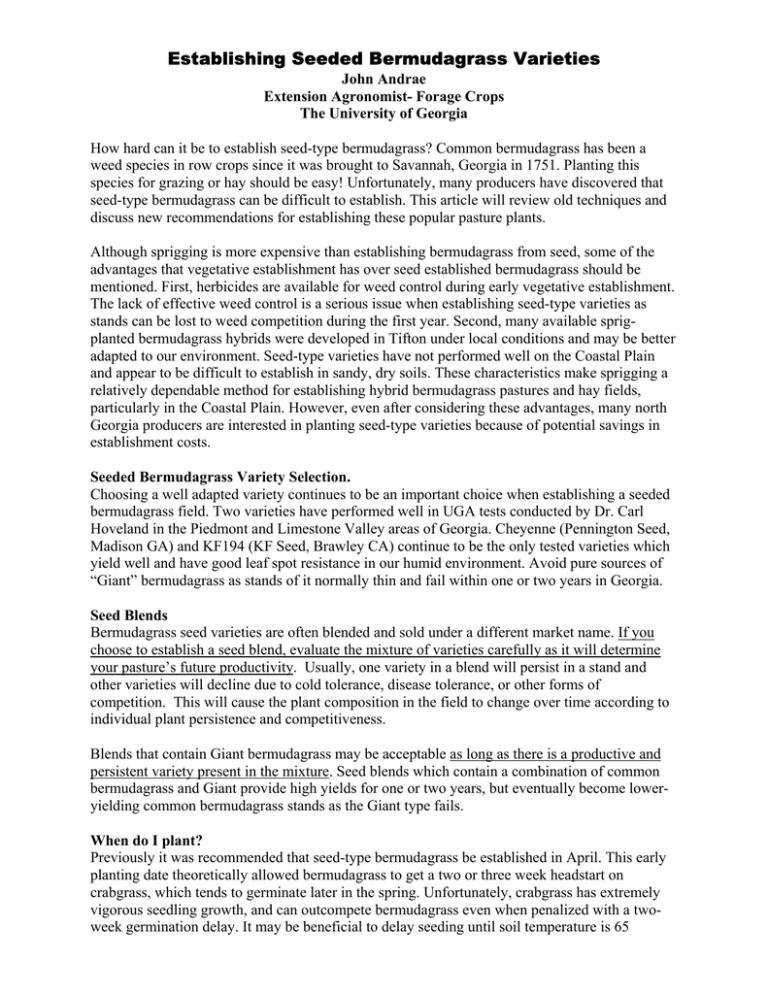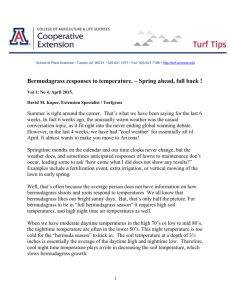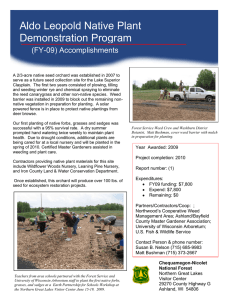Establishing Seeded Bermudagrass Varieties
advertisement

Establishing Seeded Bermudagrass Varieties John Andrae Extension Agronomist- Forage Crops The University of Georgia How hard can it be to establish seed-type bermudagrass? Common bermudagrass has been a weed species in row crops since it was brought to Savannah, Georgia in 1751. Planting this species for grazing or hay should be easy! Unfortunately, many producers have discovered that seed-type bermudagrass can be difficult to establish. This article will review old techniques and discuss new recommendations for establishing these popular pasture plants. Although sprigging is more expensive than establishing bermudagrass from seed, some of the advantages that vegetative establishment has over seed established bermudagrass should be mentioned. First, herbicides are available for weed control during early vegetative establishment. The lack of effective weed control is a serious issue when establishing seed-type varieties as stands can be lost to weed competition during the first year. Second, many available sprigplanted bermudagrass hybrids were developed in Tifton under local conditions and may be better adapted to our environment. Seed-type varieties have not performed well on the Coastal Plain and appear to be difficult to establish in sandy, dry soils. These characteristics make sprigging a relatively dependable method for establishing hybrid bermudagrass pastures and hay fields, particularly in the Coastal Plain. However, even after considering these advantages, many north Georgia producers are interested in planting seed-type varieties because of potential savings in establishment costs. Seeded Bermudagrass Variety Selection. Choosing a well adapted variety continues to be an important choice when establishing a seeded bermudagrass field. Two varieties have performed well in UGA tests conducted by Dr. Carl Hoveland in the Piedmont and Limestone Valley areas of Georgia. Cheyenne (Pennington Seed, Madison GA) and KF194 (KF Seed, Brawley CA) continue to be the only tested varieties which yield well and have good leaf spot resistance in our humid environment. Avoid pure sources of “Giant” bermudagrass as stands of it normally thin and fail within one or two years in Georgia. Seed Blends Bermudagrass seed varieties are often blended and sold under a different market name. If you choose to establish a seed blend, evaluate the mixture of varieties carefully as it will determine your pasture’s future productivity. Usually, one variety in a blend will persist in a stand and other varieties will decline due to cold tolerance, disease tolerance, or other forms of competition. This will cause the plant composition in the field to change over time according to individual plant persistence and competitiveness. Blends that contain Giant bermudagrass may be acceptable as long as there is a productive and persistent variety present in the mixture. Seed blends which contain a combination of common bermudagrass and Giant provide high yields for one or two years, but eventually become loweryielding common bermudagrass stands as the Giant type fails. When do I plant? Previously it was recommended that seed-type bermudagrass be established in April. This early planting date theoretically allowed bermudagrass to get a two or three week headstart on crabgrass, which tends to germinate later in the spring. Unfortunately, crabgrass has extremely vigorous seedling growth, and can outcompete bermudagrass even when penalized with a twoweek germination delay. It may be beneficial to delay seeding until soil temperature is 65 degrees or higher at a 4” depth. This delay should improve bermudagrass seedling vigor and disease resistance. In locations where crabgrass or goosegrass competition will not be severe, April planting is still a good option. In fields where crabgrass is known to be present, planting can be made in June or early July. Seedbed Preparation Ideally, seed type bermudagrass should be established into a well-packed clean-tilled seedbed. Prepare the ground as soon as possible in spring to allow the soil to settle. Soil test and apply recommended P, K and lime. This early preparation will also allow crabgrass and other weed species to germinate in April. These weeds can be sprayed with glyphosate (Roundup) or paraquat (Gramoxone Max) to create a weed-free seedbed. Do not disturb the soil after spraying this flush of crabgrass. Tillage will only recruit and encourage more crabgrass seed to germinate. The “second wave” of crabgrass germination should be smaller and less competitive with bermudagrass. It is possible to establish bermudagrass in killed tall fescue or small grains using a no-till drill. Remove as much residue as possible before seeding to decrease shading and improve seed/soil contact. No-till planting into living tall fescue or common bermudagrass stands is a waste of time and money because of heavy plant competition for water and light. Seed Delivery Broadcast seeding. If an early spring planting into clean tilled land is chosen, seed can be broadcast and immediately cultipacked into a firm seedbed. A simple tool to determine if the seedbed is firm enough is to walk across the field and observe footprint depth. If your boot sinks deeper than 1/8” the soil is not firm enough. Fluffy seedbeds will result in deep seed placement which can severely impact seedling emergence. Broadcasting and packing seed has been successful where crabgrass and goosegrass are absent. If crabgrass is known to be a problem, wait until June and plant using into a weed-free seedbed. No-till seeding. June plantings should be performed using a no-till drill. Seeding depth must be controlled when using this method. Make sure that seed are not being delivered deeper than 1/8”. It is often helpful to remove seed tubes from disc openers and allow seed to fall directly in front of the press wheel. This delivers seed to the soil surface and firms it into a narrow disturbed strip for good seed/soil contact. Herbicide precautions Before planting. Fields should not be sprayed with preemergence herbicides prior to planting seed-established bermudagrass. Applications of 2,4-D may also prevent establishment and should not be sprayed for a minimum three or four weeks prior to planting. Roundup or Gramoxone Max are safe when applied immediately prior to planting. These herbicides have no residual soil activity. Post planting. Broadleaf weeds can be controlled with 2,4-D after bermudagrass is well established and has developed runners that are well rooted. Again, there are no grass weed control options available for seed-established bermudagrass other than mowing. Any postemergence herbicide that injures crabgrass or goosegrass will also harm seedling bermudagrass. Frequent mowing is the only available weed control option and often is ineffective. Seeding bermudagrass can be a less expensive alternative to establishing a bermudagrass pasture. However, it also carries more risks than sprigging. Hopefully, these establishment tips will help make your seeded bermudagrass establishment a success.






